Opposing Common Core and Refusing the Tests
• Organize to Keep Matters in Our Own Hands
• Join Efforts to Refuse the Tests
• Upcoming Event: The Truth About Common Core, Testing, and Data Sharing: Why Parents Are Opting Out
• Parents and Teachers Stand United Against Common Core
•
The Defiant Parents: Testing’s Discontents • Bad Questions Are Not the Same as Hard Questions • Upcoming March Events Defending the Right to Education
Opposing Common Core and Refusing the Tests
Organize to Keep Matters in Our Own Hands
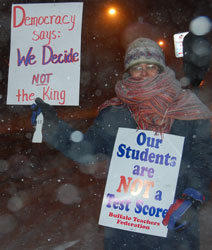 A broad movement has developed across the state to oppose the Common Core and its testing and teacher assessment regime. Meetings and actions of various kinds continue to be organized by parents and teachers themselves, various organizations defending public education and fighting to raise its quality, as well as legislators and unions.
A broad movement has developed across the state to oppose the Common Core and its testing and teacher assessment regime. Meetings and actions of various kinds continue to be organized by parents and teachers themselves, various organizations defending public education and fighting to raise its quality, as well as legislators and unions.
To contend with this movement and the general stand by the public that the Common Core is anti-education and anti-democratic, various actions by those in power have been taken. Governor Cuomo, for example, has established a “Common Core Implementation Panel” to ensure the Common Core goes forward and present the problem as one of implementation, not one of the Core itself and who decided its content and consequences. The Board of Regents has suggested delays in implementation, including the use of the testing for teacher assessments.
New legislation has also been proposed, calling for a halt to Common Core testing and use of its curriculum.
It is important to closely analyze the various proposals and take a pro-active stand toward them. Being pro-active means in part stepping up the independent organizing that has been occurring in the region and statewide. Waiting to see what will happen with legislation, or holding back on organizing efforts in the name of getting legislation passed, are not options. On the contrary, continuing to intervene on the basis of our own demands and tactics enables the movement to safeguard its momentum and its quality as a force defending the right to education and raising its quality.
Keeping matters in our own hands is also the means to bring to the fore discussion on who decides, and the need for teachers, staff, parents and students together to decide these issues of testing, standards and curriculum and all matters of public education. Buffalo Forum urges all to go all out to organize parents and students to refuse the tests in April, as a clear expression that the public says NO! This is a stand that is in our hands and one that says we stand for the interests of our children and all children and reject the harm being imposed. We will not wait for legislation. We will act now to organize to Refuse the Tests! One step in these efforts is to attend the upcoming meeting March 1 at University of Buffalo south campus on refusing the tests and urge friends and fellow workers to do the same.
Keeping matters in our own hands also means using the fight on the Common Core to insist that it is the public, the people themselves, that should decide all matters of public education. It is not the private interests, it is not the Governor, it is not Commissioner King. Democracy Means We Decide! Further advancing this discussion, including further elaborating our own alternatives for standards and curriculum can be done whether or not there is legislation or recommendations by Cuomo and his panel.
Keeping matters in our own hands also means stepping up efforts to organize public meetings and provide information on the Common Core and the agenda of the rich, facilitated by the federal government, to take over the public schools and public funds to serve their narrow private interests. We reject an agenda that says students are products — they are human beings with rights! That is why our agenda also includes discussing critical issues like poverty, racism and full funding for public education now. It includes the demand to Stop Funding War and Fund Education! It centers on the issue of who decides and firmly declares, Who Decides? We Decide!
[TOP]
Join Efforts to Refuse the Tests
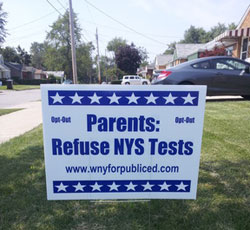 Various efforts by parents, students and teachers are going forward to refuse upcoming Common Core testing in April. The stand to refuse is a stand to say NO! to the Common Core and its harmful testing regime, which is serving to impose widespread anxiety and humiliation on students and teachers alike. It is a stand defending our youth and one that can be taken and organized independent of actions that Cuomo, Commissioner King, the Board of Regents or others may take.
Various efforts by parents, students and teachers are going forward to refuse upcoming Common Core testing in April. The stand to refuse is a stand to say NO! to the Common Core and its harmful testing regime, which is serving to impose widespread anxiety and humiliation on students and teachers alike. It is a stand defending our youth and one that can be taken and organized independent of actions that Cuomo, Commissioner King, the Board of Regents or others may take.
Students can refuse the tests by telling their teacher they refuse and then not -marking the test in any way — do not put your name or any mark on the test. Tell your friends to do the same and ask to read or go to the library. Parents can do so by informing the principal that your child is refusing the tests and by informing and urging other parents to do the same. Sample letters for this and other Refuse the Tests resources can be found at Western New Yorkers for Public Education (wnyforpubliced.weebly.com). To be better informed and join with others refusing the tests, participate in the upcoming meeting Saturday, March 1 “The Truth About Common Core, Testing, and Data Sharing: Why Parents Are Opting Out,” at UB’s south campus (see ad below).
Teachers can also take a stand, as parents and as teachers. Many teachers at recent public meetings have been expressing their opposition and elaborating on the harm the Common Core and its testing regime is imposing. Opposition to the testing is such that the New York State United Teachers (NYSUT) recently said, referring to those refusing, or opting out of the tests, “We will vigorously defend any NYSUT members who are subject to any negative employment considerations for choosing to opt out their own child or who advocate, to the extent permitted by law, for others who opt out of state standardized tests.”
Parents and teachers are also rejecting the plan by school districts to force students refusing the tests to “sit and stare” during the entire test or portions of it. In order to be counted as refusing the tests, it is necessary for students to go to school that day and sit down in class and then refuse the test. The “sit and stare” policy is thus a means to take revenge on those who refuse and discourage parents and students, especially those of elementary age, from doing so. Parents are demanding alternatives, such as going to the library. Parents can also choose to remove their child from the class, after they have refused the test. They are justly raising their concerns that “sit and stare” policies are consistent with the harmful nature of the tests themselves and should be rejected by all.
As one parent put it, “If we do not opt out, we hurt our schools… [Politicians] fear the rumble of opting out.” Responding to threats by officials to drop a school’s performance rating if refusal is widespread, the parent said, “Guess what, in one year when PARCC [the non-elected governing body for Common Core] arrives our schools are going to drop on the performance framework if you take the test. If you take the test, then you are handing over your child and your tax dollars to give them full rein to Shut Down your school. If you opt out, you cut them off. Harness your power and take your child, take your tax dollars, take your community and refuse to let them have it. We are hurting our schools by allowing them to use our children and our tax dollars to dismantle our schools. These are Our Schools. Not the corporations. Not the Department of Education. Not the politicians’ schools. Our Schools. Save your school by refusing the test.”
Buffalo Forum urges all concerned to join work to Refuse the Tests! this April and encourage fellow students, parents and teachers to do the same.
[TOP]
WNYers for Public Education presents
The Truth About Common Core, Testing, and Data Sharing:
Why Parents Are Opting Out
Panel Discussion with small group breakout sessions to follow
 Saturday March 1, 2-4pm
Saturday March 1, 2-4pm
University at Buffalo, South Campus, 105 Harriman Hall
Parents empowering parents! Have you noticed changes in your child's education? Confused about reports from the media and how it is impacting your child's classroom experience? What is Common Core, high-stakes testing, data sharing, and opt-out all about? What is fact and what is myth? Join an expert panel of parents and educators on these issues to help you decide how to guide your child through current education reforms and resistance.
[TOP]
West Seneca and Niagar Forums
Parents and Teachers Stand United
Against Common Core
 Public forums in the Buffalo area continue to affirm the united stand of parents and teachers against the Common Core and its testing and teacher evaluation regime. Two recent meetings, in West Seneca and Niagara Falls, built on meetings and actions in Buffalo against the Core, such as the 2013 meeting of thousands at Klienhans and the demonstration opposing the Core and the undemocratic, invitation-only meeting held by Education Commissioner King. Teachers, staff, students and parents in the region are joining those statewide in firmly rejecting the Common Core as anti-education and anti-democratic. This remains true despite numerous efforts by King, Governor Cuomo and the monopolies behind the Core — like Microsoft and Ford, Exxon, GE, IBM, and others — to impose them.
Public forums in the Buffalo area continue to affirm the united stand of parents and teachers against the Common Core and its testing and teacher evaluation regime. Two recent meetings, in West Seneca and Niagara Falls, built on meetings and actions in Buffalo against the Core, such as the 2013 meeting of thousands at Klienhans and the demonstration opposing the Core and the undemocratic, invitation-only meeting held by Education Commissioner King. Teachers, staff, students and parents in the region are joining those statewide in firmly rejecting the Common Core as anti-education and anti-democratic. This remains true despite numerous efforts by King, Governor Cuomo and the monopolies behind the Core — like Microsoft and Ford, Exxon, GE, IBM, and others — to impose them.
The resistance has been such that Cuomo has established an “Implementation Panel” specifically designed to counter public opposition. As has been the case with King and Cuomo, the first meeting of this panel blamed the public and claimed the problem was one of “communication.” It also called for increasing the role of the private sector. The two meetings where the public took their stand rejected this and again made clear that the problem is with the Common Core itself and with the exclusion of teachers and parents from decision making on matters of public education.
The meeting in West Seneca was attended by hundreds of parents and teachers, mainly from the district but also including those from Buffalo. It was successful in bringing together a broad panel that included teachers, staff (a librarian, speech pathologist and information officer) principals, school board member and the superintendent. Organized by the West Seneca District Parent Council, parents asked each panelist specific questions addressing the many concerns of parents and teachers alike. In opening the meeting, it was emphasized that the common concern of all was to have the best possible quality public education for all, one that is comprehensive and engaging and contributing to the needs of the youth and society more generally.
The superintendent spoke to some of the monopolies behind the Core, such as Microsoft and Pearson. He brought out that the district was mandated to implement the Common Core based on the New York State Education Department (NYSED) accepting federal Race to the Top funds. West Seneca received about $270,000 and has already spent another $300,000 to implement the Core. He spoke to how the Core narrows curriculum and reduces creativity, something echoed by the other speakers. He also emphasized that the tests are not valid, not reliable and not diagnostic. The usual feedback loop, with tests results reviewed by teachers and available to parents and utilized to assist students, has been broken. Pearson, which designs and controls the tests and their results, keeps this information secret.
He also spoke to the teacher evaluations, with 40 percent of the evaluation based on results from these invalid tests. He said they were illegitimate and wrong. He concluded saying that the Core was serving to impose a school culture that was counter to education and to using varied means to teach and learn, such as trips to museums, investigations and research at the library, and more. Other panelists also echoed this view that the Core is anti-education and stifling the conditions needed for teaching and learning.
Parents and Teachers Need Control
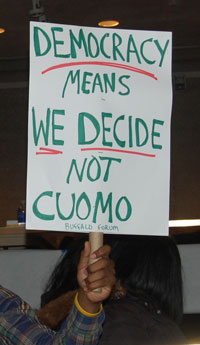 A professor of education policy and research brought out that the monopolies behind the Common Core do not look at students or teachers as human beings. They are instead seen as products, with the Common Core imposing “product specifications.” He brought out that Obama’s Race to the Top provided Education Secretary Arne Duncan with $4.35 billion to do with as he decided, with no oversight by Congress. The process for imposing the Core was both fraudulent and undemocratic. The federal -government forced states to accept it at a time when states were desperate for education funding. Many state education departments did so without even reading the standards, and in some cases before they were even completed. It is government by bribery.
A professor of education policy and research brought out that the monopolies behind the Common Core do not look at students or teachers as human beings. They are instead seen as products, with the Common Core imposing “product specifications.” He brought out that Obama’s Race to the Top provided Education Secretary Arne Duncan with $4.35 billion to do with as he decided, with no oversight by Congress. The process for imposing the Core was both fraudulent and undemocratic. The federal -government forced states to accept it at a time when states were desperate for education funding. Many state education departments did so without even reading the standards, and in some cases before they were even completed. It is government by bribery.
He also brought out that Gates and others are attempting to sway public opinion by using bribery to secure support. Gates and others gave funding to state-level Parent Teacher Associations, for example, for this purpose.
Both the content and process are being used to undermine local public institutions and state public institutions and concentrate power in the hands of a very few. He emphasized that the struggle against the Common Core is a struggle for power, for decision making by teachers and parents on issues of public education. Education is a human right and defending it defends students and teachers as human beings, not products. Governing arrangements need to affirm these rights, not undermine them.
Opposition to inBloom
The information officer spoke to the broad concern parents have with New York State’s support of inBloom, where massive amounts of private data about students and teachers is being handed over to inBloom, which is controlled by private monopolies. Students are given a number, like prisoners. The information handed over includes name, address, race, grades, disciplinary actions, absences, tardiness, homework completion, illnesses, and more, starting in pre-K. It is being done without parental consent.
The local school districts are required to forward information to NYSED, which in turn hands it over to inBloom. He raised the concern that such giant databanks are not secure and can easily be abused and used, by employers for example, to discriminate against students. InBloom itself says it will hand the data over to monopolies designing “products” for sale to schools. He spoke to the incoherence of the situation, where public schools in New York are required to hand over the data on 2.7 million students who are tracked and the data shared with private monopolies. But to receive information from inBloom concerning overall trends for schools and districts, staring in 2015 these public institutions will have to pay for it! (See p.11 for resolution passed by the Buffalo Teachers Federation opposing inBloom.)
Educating is About Making Better Human Beings, not Humiliating Children
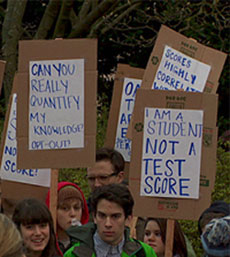 The Board of Education member and principal both spoke to the fact that Common Core was mandated by the state, but was not funded. Generally speaking, districts are being forced to spend more on all the testing and teacher and principal training required than they receive from Race to the Top. The funds spent on Common Core “slams the gate shut” on funding needed to improve the quality of public education. More importantly, they are required to impose a testing regime that is taking the curiosity, creativity and joy out of teaching and learning. It is serving to intellectually bankrupt the public school system.
The Board of Education member and principal both spoke to the fact that Common Core was mandated by the state, but was not funded. Generally speaking, districts are being forced to spend more on all the testing and teacher and principal training required than they receive from Race to the Top. The funds spent on Common Core “slams the gate shut” on funding needed to improve the quality of public education. More importantly, they are required to impose a testing regime that is taking the curiosity, creativity and joy out of teaching and learning. It is serving to intellectually bankrupt the public school system.
Teachers and other on the panel emphasized that educating children is about making better human beings who can contribute to society. The Common Core is instead creating an atmosphere of anxiety and humiliation, with hours of testing with content that is not age or developmentally appropriate and designed to cause students — and teachers and districts — to fail. There is also huge loss in instructional time, for the tests and test preparation. One spoke to how the pressures of testing are already felt in K-2 grades, with first graders often being tested at second-grade levels. Given the regime, one teacher asked, “How long will the love of learning and school last?”
A librarian spoke to the fact that they are not yet included in the teacher-evaluations and remain free of most of the Common Core mandates. As such she is still able to determine the library collection and provide for rich and diverse content. She commented on requirement now for testing required by the Core for gym, which had students leaving the gym and a time for exercise to go to the library to write about obesity! She also spoke firmly as a parent that she was refusing the testing and would be showing students that this is an important form of civil disobedience.
The many questions from the audience affirmed the broad opposition by teachers and parents alike and the damage it is causing. Many spoke to their plans to organize further, including refusing the upcoming tests in April.
Several hundred parents and educators attended a meeting in Niagara Falls on the Common Core. Most came from Niagara Falls itself but also from the Northtowns and other Niagara County Districts. Like the West Seneca meeting, it reflected the growing momentum building against the Common Core and the whole agenda of the monopolies, like Microsoft, for public education.
A parent spoke to the harmful nature of the testing regime on students, filling them with anxiety and robbing them of their desire to learn. She spoke to how private interests like Microsoft and Pearson are taking over public education and the Common Core is an example of this. She also affirmed that parents and teachers together are fighting for the interests of the children by standing firm against the Core. A special education teacher spoke to the horrors imposed on special education children with the tests. They are required to spend even longer periods, literally hundreds of hours taking tests that they do not understand. The tests are not organized with the needs of the students in mind and are instead worsening conditions for students that already have severe intellectual disabilities.
A principal spoke to known research in learning and education and brought out that the Common Core is counter to what teachers know to be sound practices, such as teamwork, encouraging investigation and discovery, recognizing different methods and paces for learning. Instead the Core draws more from factory management models, using language like outputs, efficiency, management, obedience, and so forth.
An education policy professor brought out how the entire “career and college ready” agenda is one that serves private interests and undermines public education, including the role of the public in deciding and having a say. State and federal laws are being violated as part of imposing the Core. As one example, federal law states that issues of curriculum belong to state and local bodies and the federal government is not to in any way undermine their authority. The Common Core does exactly that, as part of its attack on the public and the role of the public in governance, of the public schools and more generally. He emphasized that the fight over standards is a fight over who decides. The struggle provides an opening for parents and educators to affirm their rights and insist that they must be the decision makers, not private interests.
[TOP]
The Defiant Parents: Testing’s Discontents
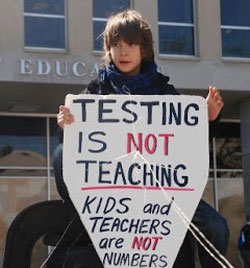 Anna Allanbrook, the principal of the Brooklyn New School, a public elementary school in Carroll Gardens, has long considered the period of standardized testing that arrives every spring to be a necessary, if unwelcome, phase of the school year. Teachers and kids would spend limited time preparing for the tests. Children would gain familiarity with “bubbling in,” a skill not stressed in the school’s progressive, project-based curriculum. They would become accustomed to sitting quietly and working alone — a practice quite distinct from the collaboration that is typically encouraged in the school’s classrooms, where learners of differing abilities and strengths work side by side. (My son is a third grader at the school.) Come the test days, kids and teachers would get through them, and then, once the tests were over, they would get on with the real work of education.
Anna Allanbrook, the principal of the Brooklyn New School, a public elementary school in Carroll Gardens, has long considered the period of standardized testing that arrives every spring to be a necessary, if unwelcome, phase of the school year. Teachers and kids would spend limited time preparing for the tests. Children would gain familiarity with “bubbling in,” a skill not stressed in the school’s progressive, project-based curriculum. They would become accustomed to sitting quietly and working alone — a practice quite distinct from the collaboration that is typically encouraged in the school’s classrooms, where learners of differing abilities and strengths work side by side. (My son is a third grader at the school.) Come the test days, kids and teachers would get through them, and then, once the tests were over, they would get on with the real work of education.
Last spring’s state tests were an entirely different experience, for children and for teachers. Teachers invigilating the exams were shocked by ambiguous test questions, based, as they saw it, on false premises and wrongheaded educational principles. (One B.N.S. teacher, Katherine Sorel, eloquently details her objections; see p.9). Others were dismayed to see that children were demoralized by the relentlessness of the testing process, which took seventy minutes a day for six days, with more time allowed for children with learning disabilities.
One teacher remarked that, if a tester needs three days to tell if a child can read, “you are either incompetent or cruel. I feel angry and compromised for going along with this.” Another teacher said that during each day of testing, at least one of her children was reduced to tears. A paraprofessional — a classroom aide who works with children with special needs — called the process “state-sanctioned child abuse.” One child with a learning disability, after the second hour of the third day, had had enough. “He only had two questions left, but he couldn’t keep going,” a teacher reported. “He banged his head on the desk so hard that everyone in the room jumped.”
As a result, Allanbrook has changed her approach to testing. This year, while tests will still be administered at B.N.S., and children in the third and fourth grades will have as much practice taking them as they ever have, the school is actively and vocally preparing to support families who decide to opt children out of the testing. Alternative activities will be provided on those days, as will alternative ways of measuring children’s progress. (Among other methods, kids who opt out of state tests will be given alternative tests produced by the Department of Education, one in English language arts and one in math, each lasting just forty-five minutes.)
Allanbrook says that her decision to speak out was motivated in part by thinking about the fifth-grade social-justice curriculum at the school, in which children who are about to graduate are asked to consider the question “What are we willing to stand up for?” “As parents and educators, this is the very question that we could be asking ourselves,” Allanbrook wrote in a letter to parents this week.
The dismay felt in the corridors of B.N.S. has not been a singular response. Throughout the city and beyond, there is a burgeoning opt-out movement, with parents, teachers, and administrators questioning the efficacy of the tests as they are currently administered, in measuring both the performance of teachers and the progress of students. More than five hundred New York State principals have signed a letter of protest, which cites the encroachment of test prep on teaching time, and the expense of test materials, which come out of stretched school budgets. Educators are also questioning the methodology of the tests, which are graded on a bell curve, with the results closely associated with socioeconomic status. Only three per cent of English-language learners in New York State passed the state tests last year, and only five per cent of students with disabilities did so. Among African-American and Hispanic students, fewer than twenty per cent passed. […]
Private Interests Deciding
The regime of testing has expanded in recent years, in the wake of [federal law] No Child Left Behind, Race to the Top [Obama’s program providing federal funding if the Common Core testing regime is adopted— BF ed. note], and a belief that what goes on in a classroom can most accurately be divined by data. Defenders of the Common Core curriculum, which seeks to insure that students nationwide are being taught according to the same standards and are meeting federally defined expectations, argue that testing is an effective means of determining whether standards have been reached, thus protecting the interests of children most at risk of being failed by the educational system.
Among the interests that standardized testing certainly does appear to be serving are corporate interests. Pearson, the largest educational publishing company in the United States, not only provides the standardized tests but also sells curricular materials for teachers to use in tailoring their teaching to the tests, test-prep materials for children to study in advance of taking those tests, and remedial materials for children to use after they have failed them. (It also inserts so-called field tests — questions for possible use in future tests — into its exams, turning public-school children into unwitting guinea pigs for procedures to be administered to other children.) In 2012, the most recent year for which it has made data available, Pearson reported that its educational-publishing revenues for North America were up two per cent, compared with an industry decline of ten per cent.
There is questionable wisdom in entrusting a for-profit corporation with measuring how well kids learn to read, write, compute, and think, the last of which is especially unlikely to be accurately gauged by industrial-scale metrics. The skepticism about Pearson was reinforced last month, when the company’s charitable arm, the Pearson Foundation, was obliged to pay $7.7 million to settle accusations that it had funded the development of educational software to be used by its for-profit parent, in violation of the law. That came after the revelation, last spring, that Pearson had flunked its own scoring of the city’s gifted-and-talented tests. Almost five thousand children were given the wrong score and were initially denied places in schools for which they were eligible.
Broad Resistance Developing
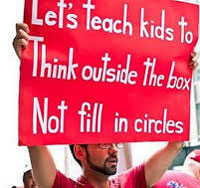 In pockets of the city and of the region, principals and teachers and parents are refusing to go along with the program. […] In one high-profile act of defiance, the Castle Bridge elementary school, in Washington Heights opted out en masse of tests for kindergartners that were what educators call developmentally inappropriate and parents call completely insane. Groups like Change the Stakes and Teachers Talk Testing are agitating for reform through the holding of town meetings, the gathering of petitions, and the making of video protests featuring despondent children and frustrated parents.
In pockets of the city and of the region, principals and teachers and parents are refusing to go along with the program. […] In one high-profile act of defiance, the Castle Bridge elementary school, in Washington Heights opted out en masse of tests for kindergartners that were what educators call developmentally inappropriate and parents call completely insane. Groups like Change the Stakes and Teachers Talk Testing are agitating for reform through the holding of town meetings, the gathering of petitions, and the making of video protests featuring despondent children and frustrated parents.
In a recent poll of New York City voters, twenty per cent said that education should be the top priority of Mayor Bill de Blasio — a higher proportion than for any other single issue. […]
Parents who complain about testing — particularly affluent, educated ones — are easily derided, as they were by Arne Duncan, President Obama’s Education Secretary, a few months ago, when he described critics of the Common Core as “white suburban moms who — all of a sudden — [find] their child isn’t as brilliant as they thought they were, and their school isn’t quite as good as they thought they were.” But parents who challenge the status quo on testing are not motivated by a deluded pride in their children’s unrecognized accomplishments, or by a fear that their property values will diminish if their schools’ scores’ drop. They are, in many cases, driven by a conviction that a child’s performance on a standardized test is an inadequate, unreliable measure of that child’s knowledge, intelligence, aptitude, diligence, and character — and a still more unreliable measure of his teachers’ effort, skill, perseverance, competence, and kindness.
They are also motivated by the belief that those parents who are least equipped to speak out are the mothers and fathers of the children who are most vulnerable — the most likely to have their educations diminished by months of repetitive test prep, most likely to find themselves reduced to the statistical data at the wrong end of the bell curve. Parents in this year’s opt-out movement are standing up for something larger than their own child’s test-day happiness: the conviction that all children have better things to do with their days than fill in bubbles on a multiple-choice sheet, and that all children have better things to do with their heads than bang them against a table in despair.
[TOP]
Bad Questions Are Not the Same as
Hard Questions
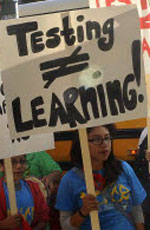 We have been hearing recently about how “hard” the recent state tests were. We are told that they had to be “hard” because we have to raise the standards in order to make sure all our students are college-ready.
We have been hearing recently about how “hard” the recent state tests were. We are told that they had to be “hard” because we have to raise the standards in order to make sure all our students are college-ready.
Having proctored the fifth-grade tests in spring 2013, I have to wonder where the folks at testing company Pearson went to college [Pearson is a private monopoly that writes the Common Core tests, demands they be kept secret and controls results of the tests, informing teachers and parents only whether their child is a 1, 2, 3, or 4, with 1 being the lowest — BF ed note].
From my vantage point, the tests suggested that the designers have had little direct experience with literature, history, or math. The tests were hard in the sense that they were hard to do well on. But they were hard to do well on because they were poorly designed, with little connection to the work that students should be doing in school, at the fifth grade or at college.
Here are some key problems I encountered with the latest state tests:
Problem #1: There is not one right answer in literature
When I teach fiction, I emphasize that different interpretations and opinions are fine, as long as students can support their ideas with evidence from the text. Yet for three days in April, fifth graders were asked to read poems and stories and identify the one and only one theme of the selection. Not a main idea — I believe it is possible to pinpoint one main idea in reading selection — but one theme, as if a story cannot be about both friendship and trying new things.
This could be fair if three of the four choices provided were clearly wrong, yet they were not. As a savvy test-taker, I could usually identify which choice Pearson considered right. But as I watched students make their “wrong” choices, I could see how they could make a beautiful argument with evidence from the text to support their answer. And sometimes I could not choose. One question had two choices that were different ways of saying the exact same thing and another had two choices that seemed equally possible, no matter how many times I reread the poem in question.
As a teacher, I know how to prepare students for college and I know how to assess their reading; this test did not do either.
Problem #2: Expository texts require visuals
Reading expository texts is challenging for many students at any level, including college. Good texts are filled with maps, graphs, photos, charts, etc. to help the reader visualize and organize new information. In fact, good teaching involves teaching students how to read all those visuals and integrate the information provided with what is in the text, and we should be assessing whether students can do that. Yet Pearson expected fifth graders to comprehend an article about Jefferson’s vision for westward exploration that ultimately led to the Lewis and Clark expedition while providing no visuals.
There was no map to help students understand that “The United States” was just a tiny sliver of the land between the Atlantic and Pacific Oceans, or what “The Louisiana Purchase” referred to. There was no timeline to help students grasp the time span covered in a few short paragraphs or to keep track of the different generations of Clarks. This was not an example of challenging text; this was an example of poor text, making it a poor assessment.
Problem #3: Math should make sense
We hear a lot about students who can perform the basic operations in math but cannot apply them. Presumably the new test would ask students to apply their math skills to real-life situations. Instead, Pearson’s goal seemed to be to come up with situations that would never happen in real life to test students’ stamina and ability to complete nonsensical operations.
A person has change in her pocket. She spends varying amounts at various places. In the end she has 1/45 left; how much money does she have. 1/45? When in college or life does anyone have occasion to work with forty-fifths? In another question we learn how long it takes kids to do something a certain number of times, and the question is how long does it take them to do it one time. The answer, which all the fifth graders I was with could figure out, was four minutes. The problem? Pearson wanted the answer in hours, and since it was not multiple choice, it was anyone’s guess what answer they were looking for. I hoped that the kids that wrote “1/15 hour” got it right.
Question after question, either the scenario described made no sense or the math required made no sense. I like math. I think it can be fun and I know it is useful. But this test was like math through the looking glass because there was no point to any of it, least of all to assess students’ math skills.
If Pearson stood by their tests, they would release them to the public and let the public be the judge. And I would challenge any adults that think these tests reveal something about children’s learning to take the tests themselves. I would love to see those scores.
[TOP]
Rally to Defend the Right to Education
and Demand Full Funding Now
March 7, 6:30 p.m. rain or shine
Niagara Square, Buffalo
Rallying for:
• Saving arts, music, AP courses, foreign languages, afterschool programs, kindergarten, student support services, and a love of learning.
• Demadning Investments of $1.9 billion in New York Public Schools K-20
Sponsored by NYSUT
* * *
League of Women Voters Presents:
Learning More About the Common Core
Wednesday, March 12, 7-9pm
Unitarian Universalist Church, 695 Elmwood, Buffalo
Keynote Speaker: Dr. Mark Garrison
Areas of Discussion for Panel of Speakers:
Origin of Common Core, Relation to No Child Left Behind and Race to the Top, testing, privacy concerns (inBloom) and implementation. Q&A to follow panel
[TOP]
